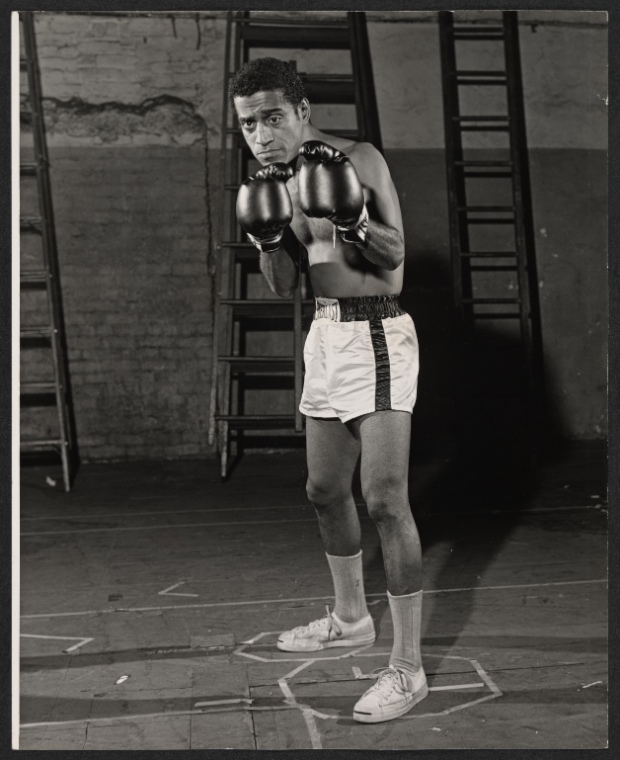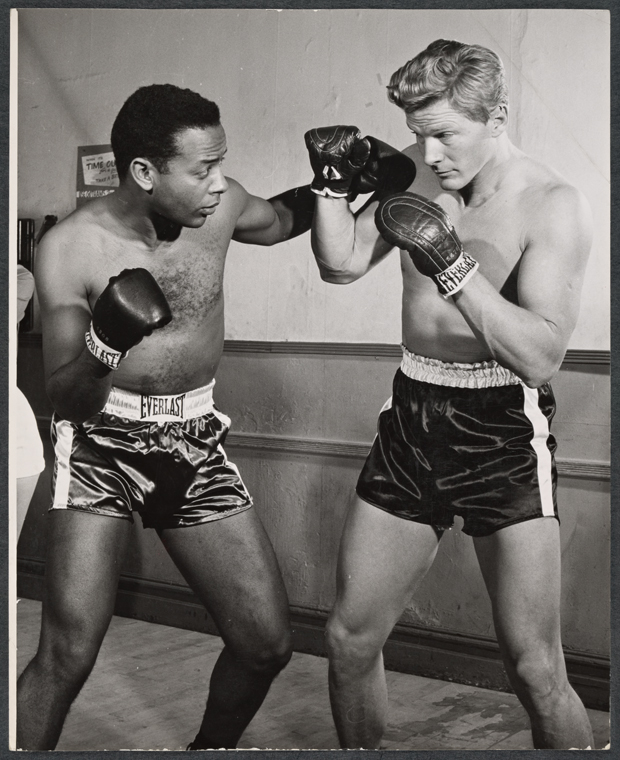Musical of the Month
Musical of the Month: The Body Beautiful
Spoiler alert: The following blog reveals details about the plot of Rocky. If you’ve seen the movie, there are no surprises here, but if you haven’t seen it yet, go buy a ticket to the musical, and come back soon.
 Rocky on Broadway (Photo by Murphy Made)
Rocky on Broadway (Photo by Murphy Made)
When Thomas Meehan spoke at the library last week, he confessed that when Sylvester Stallone first approached him about the possibility of turning Rocky into a musical, he was initially skeptical. Boxing does not immediately suggest power ballads and chorus numbers.
Of course, one might argue, neither does a cannibal barber or goofy Mormons in war and AIDS ravaged Africa. Yet Sweeney Todd, The Book of Mormon, and Rocky work because they are not, fundamentally, about cannibals, the Latter Day Saints, or boxing. Each show uses these specifics as a kind of “excuse” for telling much more universal stories. Much of the basic plot of revenge and class struggle in Sweeney Todd was earlier told in Mozart’s Figaro operas (and, less musically, in Shakespeare’s Titus Andronicus). The Book of Mormon’s critique of unthinkingly blind faith and colonizing philanthropy co-opts bits of The King and I and Candide. And Rocky, as Thomas Meehan realized after re-watching the film with Stallone, is, at heart, Cinderella—a story that has been successfully told with song and dance so many times that the current Broadway production must indicate in its title that it is Rodgers and Hammerstein’s particular version.
Of course, Rodgers and Hammerstein’s Cinderella is told with fairy godmothers, magical gowns, and a royal ball—in short, the chromatic scale of musical theater. Rocky is told in Philadelphia slums with slabs of beef, loan sharks, and a boxing ring. The underlying archetypes may be what matter most, but the particular details are what appear in newspaper ads and Shubert Alley posters. It might not be, as Meehan claims, a musical about boxing, but it is still a musical with boxing—and lots of it. And, admittedly, that seems strange.
But it isn’t exactly new.
In 2011, Connecticut’s Goodspeed Opera (where Meehan’s Annie was first staged) produced Cutman, a musical about a Jewish boxer who must decide whether to honor his traditions or fight on the eve of Yom Kippur. In 1964 Meehan’s Annie collaborator, Charles Strouse, wrote the score to a musical adaptation of Clifford Odets’s play Golden Boy in which the protagonist (played in the musical version by Sammy Davis, Jr.) is convinced, against his father’s wishes and advice, to become a prizefighter. Still earlier, in 1958, Bock and Harnick joined together with Joseph Stein on their first Broadway musical—The Body Beautiful—which featured an upper class Princeton philanthropist who begins boxing to entertain and win the respect of the trouble youth at a local community center, and then realizes that he enjoys it too much to quit.
In February of 2009, when Rocky, the musical, was still just a rumor, Broadway producer Ken Davenport wrote a short blog after watching Rocky IV in which he noted that, apart from Good News and Damn Yankees, there haven’t been many successful “sports musicals.” That being the case, it’s somewhat remarkable that boxing has been a subject so frequently taken up by writers of musical theater. The final bell still hasn’t sounded on Rocky, and Cutman has not yet made it to Broadway, but neither The Body Beautiful nor Golden Boy was a commercial hit. Why then do writers and producers keep creating new sports musicals, and not just sports musicals, but boxing musicals in particular?

Bob, in The Body Beautiful, initially pursues boxing for noble reasons (to connect with disadvantaged kids), but is seduced by the glory of the game. In Cutman, boxing stands in opposition to the protagonist’s faith. Boxing, then, comes to represent an externalization an internal struggle—just the kind of thing musical theater songs from Billy Bigelow’s “Soliloquoy” to Jean Valjean’s “Who am I?” have been doing for years.
In Rocky, though, the choice is different. Here, the boxing match represents, not an internal struggle with a moral dilemma, but the heroism of struggling and preserving in the face of the cruel and impersonal opposition one encounters just by living. Victory does not include, and in fact could never conceivably include, vanquishing one’s opponent, but is instead surviving to tell about the defeat. At the start of the show, where a musical theater protagonist might usually declare what he wants, Rocky reflects on the fact that despite all that life has thrown at him, his “nose ain’t broken.”
In the final match, against very uneven odds, despite suffering round after round of punishing blows, Rocky keeps fighting. Although he does not ultimately win, he “goes the distance” (fights 15 rounds without being knocked out), and, at last, his nose his broken. If this all sounds very dark and existentialist, well, it kind of is, but on Broadway, it is set to fantastic Ahrens and Flaherty score and brilliantly staged with a 20 minute fight sequence that is one of the most exciting and spectacular scenes on Broadway in recent memory.
So, yes, boxing is a strange topic for a musical, but not, perhaps, as strange as it might initially seem.
This month’s musical of the month celebrates the earliest of the boxing musicals described here: The Body Beautiful.

Although the musical wasn’t ultimately a commercial success, it was a successful in uniting for the first time on Broadway, Jerry Bock and Sheldon Harnick. In his professional biography of Bock and Harnick—To Broadway, To Life!: The Musical Theater of Bock and Harnick, Philip Lambert writes that the musical was originally conceived by bookwriter Joseph Stein and William Glickman while they were working on an earlier musical with Bock—Mr. Wonderful (starring, it may be worth noting, Golden Boy’s Sammy Davis Jr.). Mr. Wonderful was, according to Lambert and most who have discussed it on record, a relatively tense collaboration, and so when Bock was brought on to work with Stein and Glickman on their new boxing show, the team sought a new lyricist. Through what Lambert calls “a convergence of several forces” (including Stein’s admiration of Harnick’s work on an earlier piece, Horatio), Sheldon Harnick was hired. Though most involved acknowledge that the musical was not a hit, it will be remembered as the show that brought together Bock and Harnick.
A note on the text(s):
All of the texts below are made available through the kind permission of the rights holders for research use only. You may not repost or otherwise publish the images below without permission from the rights holders. If you are interested in staging a production of The Body Beautiful, please contact Samuel French.
Read the published script:
Read E-Books with SimplyE
 With your library card, it's easier than ever to choose from more than 300,000 e-books on SimplyE, The New York Public Library's free e-reader app. Gain access to digital resources for all ages, including e-books, audiobooks, databases, and more.
With your library card, it's easier than ever to choose from more than 300,000 e-books on SimplyE, The New York Public Library's free e-reader app. Gain access to digital resources for all ages, including e-books, audiobooks, databases, and more.
If you don’t have an NYPL library card, New York State residents can apply for a digital card online or through SimplyE (available on the App Store or Google Play).
Need more help? Read our guide to using SimplyE.